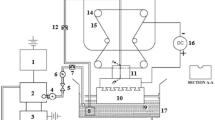Abstract
A nickel-based high-temperature alloy widely used in aerospace engines is a typical difficult-to-cut material by conventional machining processes due to its high-temperature mechanical strength and toughness. Blasting erosion arc machining (BEAM), a new type of electrical discharge machining (EDM) method, is capable of removing such materials with a very high material removal rate and a low tool wear ratio. This paper presents experimental investigations in machining characteristics and machined surface integrity of the nickel-based alloy GH4169 (similar to Inconel718) by positive polarity blasting erosion arc machining (positive BEAM). The test results imply a possibility to improve the surface integrity with positive BEAM compared with a regular negative one. In this work, a three-factor, three-level machining performance experiment was carried out to examine the effects of the machining parameters such as discharge peak current, flushing inlet pressure, and pulse duration on the machining performances of material removal rate, tool wear ratio, and surface roughness. The experimental results show that positive BEAM is capable of greatly improving the machined surface integrity. The surface roughness decreased from 274 μm (under negative polarity BEAM) down to 31 μm (under positive polarity BEAM). Additionally, fewer micro-cracks and a thinner heat-affected zone on the workpiece surface can be observed. It also reveals that by optimizing the combination of the negative and the positive BEAM, favorable machining performances of high material removal rate and finer surface roughness are possible. By utilizing the polarity effects, the machining allowance for the subsequent semi-finishing processes such as cutting can be further reduced.
Similar content being viewed by others
References
Klocke F, Klink A, Veselovac D, Aspinwall DK, Soo SL, Schmidt M, Schilp J, Levy G, Kruth JP (2014) Turbomachinery component manufacture by application of electrochemical, electro-physical and photonic processes. CIRP Ann Manuf Technol 63:703–726
Zhu D, Zhang X, Ding H (2013) Tool wear characteristics in machining of nickel-based superalloys. Int J MachTools Manuf 64:60–77
Rahman M, Seah WKH, Teo TT (1997) The machinability of Inconel1718. J Mater Process Technol 63:199–204
Dudzinski D, Devillez A, Moufki A, Larrouquère D, Zerrouki V, Vigneau J (2004) A review of developments towards dry and high speed machining of Inconel718 alloy. Int J MachTools Manuf 44:439–456
Tian X, Zhao J, Zhao J, Gong Z, Dong Y (2013) Effect of cutting speed on cutting forces and wear mechanisms in high-speed face milling of Inconel 718 with Sialon ceramic tools. Int J Adv Manuf Technol 69:2669–2678
Mirahmadi SJ, Hamedi M, Ajami S (2014) Investigating the effects of cross wedge rolling tool parameters on formability of Nimonic® 80A and Nimonic® 115 superalloys. Int J Adv Manuf Technol 74:995–1004
Narutakia N, Yamanea Y, Hayashib K, Kitagawac T, Uehara K (1993) High-speed machining of Inconel 718 with ceramic tools. CIRP Ann Manuf Technol 42(1):103–106
Thakur DG, Ramamoorthy B, Vijayaraghavan L (2009) Study on the machinability characteristics of superalloy Inconel718 during high speed turning. Mater Des 30:1718–1725
M’Saoubi R, Axinte D, Herbert C, Hardy M, Salmon P (2014) Surface integrity of nickel-based alloys subjected to severe plastic deformation by abusive drilling. CIRP Ann Manuf Technol 63:61–64
Madariaga A, Esnaola JA, Fernandez E, Arrazola PJ, Garay A, Morel F (2014) Analysis of residual stress and work-hardened profiles on Inconel 718 when face turning with large-nose radius tools. Int J Adv Manuf Technol 71:1587–1598
Meshcheriakov G, Nosulenko V, Meshcheriakov N, Bokov V (1988) Physical and technological control of arc dimensional machining. CIRP Ann 37(1):209–212
Yuan R, Wei B, Luo Y, Zhan Y, Xu W, Lamphere M (2010) High-speed electroerosion milling of superalloys. ISEM 16:207–210
Ye J, Wu G, Wang F, Wu Q, Xu L, Luo G (2011) The orthogonal test and reach on the optimum parameters of the pulse power in NC high performance electrical-discharge milling. Electromachining Mould 6:16–20
Zhao W, Gu L, Xu H, Li L, Xiang X (2013) A novel high efficiency electrical erosion process—blasting erosion arc machining. Procedia CIRP 2013(6):622–626
Wang F, Liu Y, Shen Y, Ji R, Tang Z, Zhang Y (2013) Machining performance of Inconel 718 using high current density electrical discharge milling. Mater Manuf Process 28:1147–1152
Wang F, Liu Y, Zhang Y, Tang Z, Ji R, Zheng C (2014) Compound machining of titanium alloy by super high speed EDM milling and arc machining. J Mater Process Technol 214:531–538
Wang F, Liu Y, Tang Z, Ji R, Zhang Y, Shen Y (2014) Ultra-high-speed combined machining of electrical discharge machining and arc machining. Proc Inst Mech Eng B J Eng Manuf 228(5):663–672
Author information
Authors and Affiliations
Corresponding author
Rights and permissions
About this article
Cite this article
Xu, H., Gu, L., Chen, J. et al. Machining characteristics of nickel-based alloy with positive polarity blasting erosion arc machining. Int J Adv Manuf Technol 79, 937–947 (2015). https://doi.org/10.1007/s00170-015-6891-y
Received:
Accepted:
Published:
Issue Date:
DOI: https://doi.org/10.1007/s00170-015-6891-y



